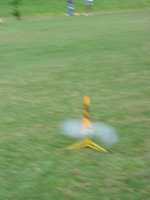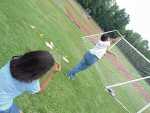

 |
There were two types of rockets: the Alpha II and generic. The first thing that you have to assemble is the engine assembly unit, what the engine is going to sit in. Then, you have to glue the launch lug to the side of the rocket. Next, you glue in the shock cord in the body tube and tie it and the parachute on the nose cone. |
| Then, you stuff the rocket with wadding, to keep the rocket from burning, then you pack the parachute. There where two different types of engines: the A8-3 and B6-4. The difference between the A8-3 and B6-4 engines is that the A8-3 engine provides more force than the B6-4 engines, but the force doesn't last as long as it does in the B6-4 engines. First, we tested with the A8-3 engines. You put the engine in the engine assembly unit. Then, you get an igniter and a plug to keep it in. After that, you put the rocket onto the stand by sliding it down the rod, through the launch lug. We used the angle in which the rocket went up. |  |
 |
Of course, the generic rockets didn't go nearly as high as the Alpha II rockets did, however, they did go higher than expected. The distance flown by each rocket ranged from thirty feet from the launch pad to the far end of the lacrosse field, with the A8-3 engine. With the B6-4 engine, the distance flown was from the edge of the trees, to one that wasn't seen from again. The best part of the launch was catching them. |
  by Charles Tuck II and Gabriel Knop |
 |
